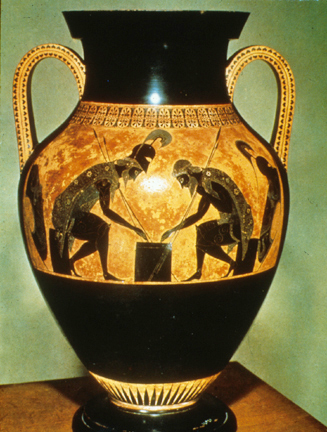This amphora shows the increasing skill of the Athenian vase painter in depicting the human form and in telling the human story. It was common for the vessel to be thrown and assembled by one person, while the painting was accomplished by another. This amphora is particularly well proportioned, with its volume swelling from the foot to its shoulder, from which elegant handles spring to the neck. The painter of this amphora, Exekias, was a painter who excelled in composition and that is evident here, where light and dark areas are skillfully balanced. The scene is from the Trojan Ware, and we see two of the most famous figures from this story, Achilles and Ajax. Achilles is at left, and Ajax is on the right. Both have rested their shields and spears, and Ajax has removed his helmet. Note the skillful way in which Exekias has drawn the spears to create a triangular line which leads the eye to the handles. Also see how this line is completed by the shapes of the shields, bringing our eyes back into the composition. These two warriors are shown taking a respite from their battles, and playing a game of checkers (draughts) on a board. They intently focus on the game, moving their pieces around the board. Note the frontal eye, which seems to stare at the viewer, even though they are looking at the game board. While body proportions are still not anatomically correct, Exekias indicates volume and shape by using sgraffito, carving linear detail into the black shapes of the figures. Rather than focusing on the battles to come, Exekias here captures the more human moment of two warriors at rest, trying to take their minds off their worries of what is soon to come. A double honeysuckle frieze surrounds the vessel above the action. The population at this time was mostly illiterate, but the action depicted here would have been recognized by most people. The story illustrated here is of a war that took place over 600 years before this vase was painted, and together with the writings of Homer, these vases vividly illustrate the history of this time.
Achilles is best known from the phrase 'Achilles Heel.' He was the commander of the Trojan army and thought to be invincible. As a child, his mother, Thetis, a sea nymph, in order to protect him from harm, dipped him into the waters of the underworld river Styx. These waters would confer invulnerability to anyone who was immersed. However, his mother held the young Achilles by his heel as she dipped him, and this part of his body was not protected. The phrase 'Achilles Heel' has come to mean any point of vulnerability. He was later killed in battle from an injury to his vulnerable spot, and his second in command, Ajax, rescued his body from the enemy Trojans.

Achilles and Ajax at Draughts, Black Figure Ware Amphora
Greek, 540 BCE


